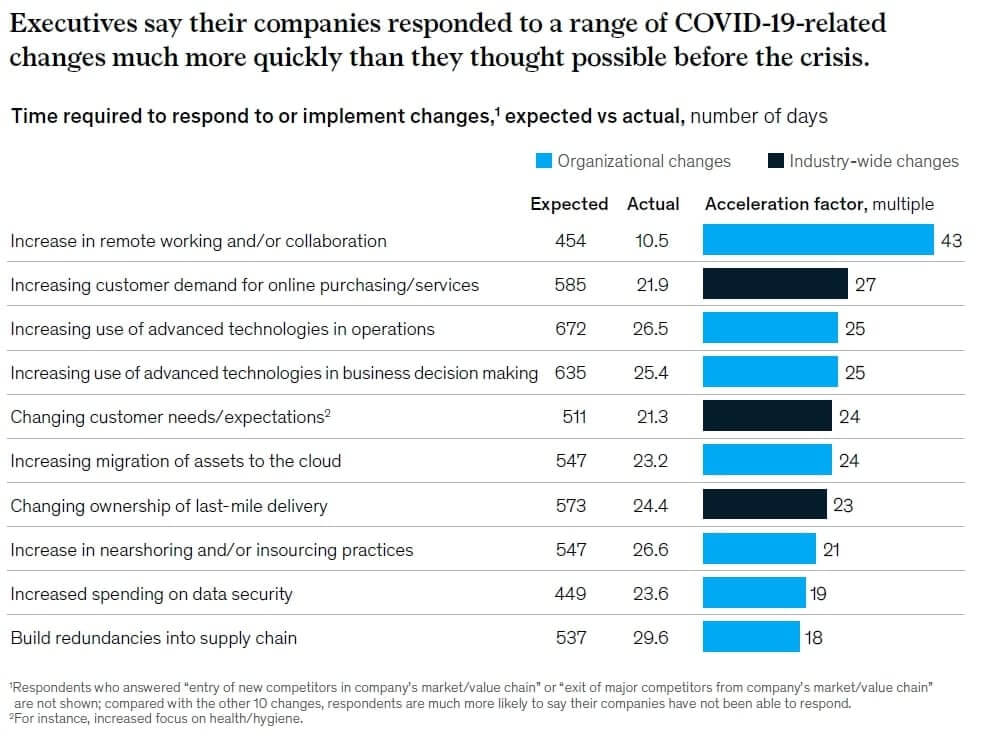Increase of telework, digitalization of interactions, migration to the cloud… What if the COVID-19 crisis had been a source of opportunities for companies?
According to a recent study by McKinsey, the health crisis has accelerated the digital transformation of companies by nearly seven years. Conducted in July 2020, this study questioned about 900 executives worldwide—from all company sizes and sectors—on the organizational and technological changes caused by the crisis.
What were these changes? Are they sustainable? Here’s a summary of the study’s key insights.
A leap forward for digital adoption
During the COVID-19 crisis, consumers have massively migrated their shopping to digital channels. To meet this new demand, companies have had to digitalize the products and services they offer at full speed—as well as their method of distribution. According to McKinsey, 55% of customer interactions are now digital in Europe, representing a 3-year leap forward from pre-crisis forecasts.
In all sectors, the biggest change is seen in the online offerings. To date, half of European products and services are already digitized. McKinsey considers that the crisis has accelerated the digitization of offers in Europe by about seven years—and by more than 10 years in Asia-Pacific.
However, this digitization is not homogeneous in all sectors:
- In packaged consumer goods and in the automotive and assembly industries, the portfolio of digital products has changed very little.
- In the pharmaceutical, healthcare, and financial industries and in the professional services sector, on the other hand, McKinsey has noted a leap forward almost twice as large.
If this digitalization has a beneficial effect on companies, why didn’t they implement it earlier?
For more than half of the respondents, the reason is obvious: it wasn’t a priority before. In addition, other barriers could exist in B2B companies, including resistance to change, lack of IT infrastructure, or organizational silos.
Also read: Digital Transformation in 5 Challenges and 25 Keywords
A perpetuation of the largest changes
Within companies, the crisis has brought about three major changes:
- increased telework and/or collaboration
- shifting customer needs or expectations
- increased demand for online services and/or products
The study also cites several other changes related to the crisis, including:
- increased spending on data security
- increased use of advanced technologies
- accelerated migration to the cloud
- supply chain restructuring and qualification of additional suppliers
- increase in nearshoring and insourcing practices
According to the professionals surveyed, companies have adapted to all these changes 20 to 25 times faster than expected. Before the crisis, the consulting firm estimates that it would have taken more than a year to implement teleworking, yet during the crisis, companies typically managed to implement it in a span of just 11 days!

Also read: After-COVID: What’s Next for Teleworking?
So, what changes will remain after COVID? According to McKinsey, three criteria must be considered:
- cost effectiveness
- the ability to meet customer needs
- benefits for the company
Based on these criteria, the study notes that the larger changes cited above are the most likely to be sustainable in the future. For example, 54% of professionals believe that teleworking will continue after the crisis. And this is the most significant and cost-effective change the crisis has brought us.
A winning, technology-driven strategy
Everyone understands that digital is taking on an increasingly important role in organizational strategy. Technology has even helped companies to respond effectively to the crisis. Indeed, 72% of the respondents who started to use new technologies first during the crisis report good management of COVID-19 in their company, compared with only 33% for the rest of the companies.
Furthermore, organizations that have tested and invested in new technologies during the crisis are twice as likely to experience high growth in 2020.
The results also indicate that the crisis has led to a change in the perception of technology roles in business:
- In 2017, almost half of the executives surveyed ranked cost savings as one of the highest priorities in their digital strategies.
- Today, only 10% see technology in the same way, and now more than half of respondents say they want to invest in technology—or even refocus their entire business on technology—to create a competitive advantage.
This shift in mindset is all the more common in companies whose revenues were already declining before the crisis. In fact, 45% of those companies that experienced the biggest revenue decline say they have refocused their strategy on digital, compared to only 24% for those whose revenues increased the most.
In addition, technological capabilities have been key success factors during the crisis, including the ability to bridge the IT talent gap, to use cutting-edge technologies, and to quickly test new technologies.
Having a culture that encourages experimentation and responsiveness has been key. For example, more than half of the companies that best managed the crisis say they were the first to use digital technologies. These companies are more likely to accelerate the flow of critical information and the reallocation of resources to fund new initiatives—all of which are key aspects of a business culture that encourages experimentation.
*
* *
According to McKinsey, the COVID-19 crisis was a breaking point for companies in terms of digitalization.
Although they have been forced to make many changes in a hurry, these initiatives are more likely to benefit them in the long term. Indeed, teleworking and the demand for digital offerings will most certainly continue—and even grow—in coming years, so it’s essential for businesses to invest in digital now.
Interested in learning more about Covid’s impact on the digitalization of companies? Check out our summary of Stormshield’s latest study, “Corporate digital transformation: putting maturity to the test?”
_
Author: Emmanuelle Abensur




